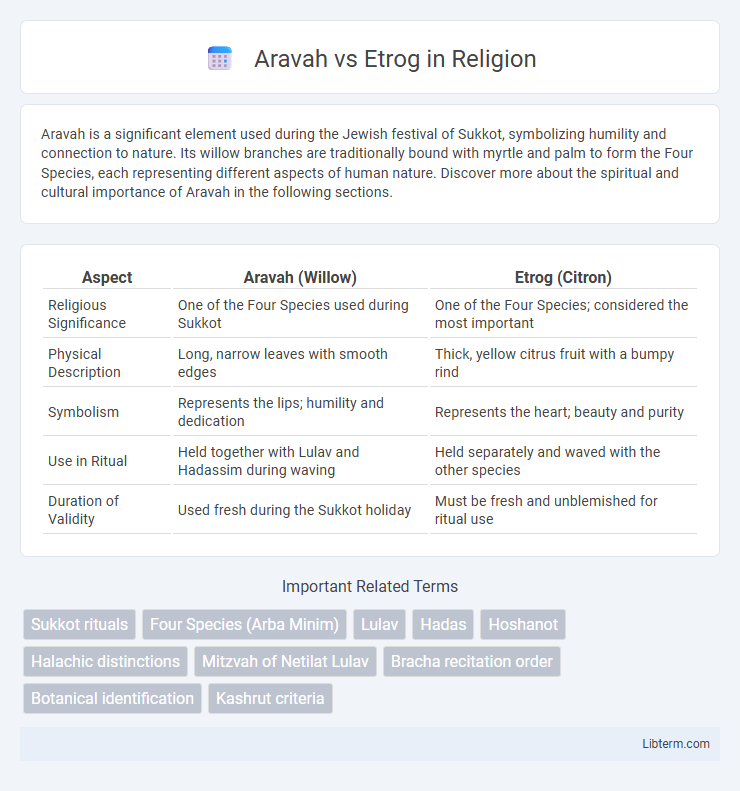Aravah is a significant element used during the Jewish festival of Sukkot, symbolizing humility and connection to nature. Its willow branches are traditionally bound with myrtle and palm to form the Four Species, each representing different aspects of human nature. Discover more about the spiritual and cultural importance of Aravah in the following sections.
Table of Comparison
| Aspect | Aravah (Willow) | Etrog (Citron) |
|---|---|---|
| Religious Significance | One of the Four Species used during Sukkot | One of the Four Species; considered the most important |
| Physical Description | Long, narrow leaves with smooth edges | Thick, yellow citrus fruit with a bumpy rind |
| Symbolism | Represents the lips; humility and dedication | Represents the heart; beauty and purity |
| Use in Ritual | Held together with Lulav and Hadassim during waving | Held separately and waved with the other species |
| Duration of Validity | Used fresh during the Sukkot holiday | Must be fresh and unblemished for ritual use |
Introduction to Aravah and Etrog
The Aravah and Etrog are integral elements in the Jewish festival of Sukkot, symbolizing distinct aspects of nature and spirituality. The Aravah, or willow branch, represents humility and connection to water, used specifically for its leaves during the festival rites. The Etrog, a citron fruit, is prized for its fragrance and beauty, symbolizing a heart full of good deeds and devotion.
Historical Origins of Aravah and Etrog
The Aravah (willow branch) and Etrog (citron fruit) have distinct historical origins rooted in ancient Jewish agricultural and religious traditions. The Etrog originates from the citron tree, primarily cultivated in the Mediterranean and Middle Eastern regions, symbolizing purity and beauty in Jewish rituals during Sukkot. The Aravah, derived from the willow tree native to riverbanks in the Land of Israel, represents humility and connection to water, both essential elements in the observance of the Four Species.
Botanical Differences: Aravah vs Etrog
Aravah, scientifically known as Salix species, exhibits long, narrow leaves typical of willow trees, contrasting sharply with the Etrog (Citrus medica), which bears thick, bumpy, and aromatic fruit with broad, glossy green leaves. While Aravah is prized for its flexible branches, the Etrog is distinguished by its unique citrus fragrance and ornamental fruit, critical in Jewish ritual use during Sukkot. The significant botanical differences between the woody, slender Aravah and the thick-skinned, fragrant Etrog highlight their distinct taxonomic classifications and ecological adaptations.
Symbolic Meanings in Jewish Tradition
The Aravah, representing the willow branch, symbolizes humility and the need for water in Jewish tradition, reflecting the fragility and dependence on divine sustenance. The Etrog, a citron fruit, embodies beauty, fragrance, and a heart filled with good deeds, symbolizing spiritual perfection and completeness. Together, during the festival of Sukkot, they form part of the Four Species that convey unity among diverse qualities within the Jewish community.
Ritual Uses During Sukkot
Aravah and Etrog serve distinct ritual purposes during Sukkot, with the Aravah (willow branch) symbolizing humility and collected as part of the Four Species for waving in the synagogue and ritual blessings. The Etrog (citron), prized for its fragrance and appearance, is held together with the other species--Aravah, Lulav (palm frond), and Hadass (myrtle)--during prayers to fulfill the commandment of the Four Species (Arba Minim). Each species, including the Aravah and Etrog, plays a vital role in expressing unity and gratitude in Sukkot observances according to Jewish law (Halacha).
Harvesting and Selection Guidelines
Harvesting Aravah involves cutting the flexible willow-like branches just before the leaves fully mature, ensuring they remain pliable and retain vibrant green color. Etrog harvesting requires careful picking when the fruit turns bright yellow but is not overripe, avoiding blemishes and cracks to meet strict kosher standards. Selection guidelines emphasize the Aravah's intact leaves without damage and the Etrog's symmetrical shape, firm texture, and absence of insect marks or mold for optimal ritual use.
Care and Preservation Methods
Aravah branches require careful handling to avoid bruising the delicate leaves, and storing them in a cool, humid environment extends their freshness. Etrog citrus fruits need gentle washing to remove residues, followed by wrapping in soft cloth or placing in a protective box to prevent blemishes during storage. Maintaining optimal humidity and temperature levels for both ensures the longevity and vitality essential for ritual use during Sukkot.
Common Ritual Mistakes to Avoid
Confusing the Aravah with the Etrog during the Four Species ritual can lead to invalid blessings, as the Aravah is a willow branch while the Etrog is a citron fruit. Common mistakes include holding the Aravah in place of the Etrog or neglecting to bind the Aravah with the Hadas and Lulav properly. Ensuring the correct identification and handling of each species preserves the ritual's validity and honors its traditional requirements.
Cultural Significance in Modern Judaism
The Aravah and Etrog hold profound cultural significance in modern Judaism, symbolizing unity and spiritual reflection during the festival of Sukkot. The Etrog, a citron fruit, represents the heart and purity, while the Aravah, a willow branch, symbolizes humility and connection to nature. Together, they embody essential themes of gratitude, renewal, and communal identity in contemporary Jewish practice.
Conclusion: Choosing Between Aravah and Etrog
Choosing between Aravah and Etrog depends on the specific mitzvah requirements and symbolic meanings in Jewish tradition during Sukkot. Aravah, representing humility and community, is essential for the Four Species, while Etrog symbolizes beauty and heart, making it crucial for fulfilling the mitzvah properly. Understanding their distinct spiritual roles ensures an informed and meaningful selection in observance.
Aravah Infographic

 libterm.com
libterm.com